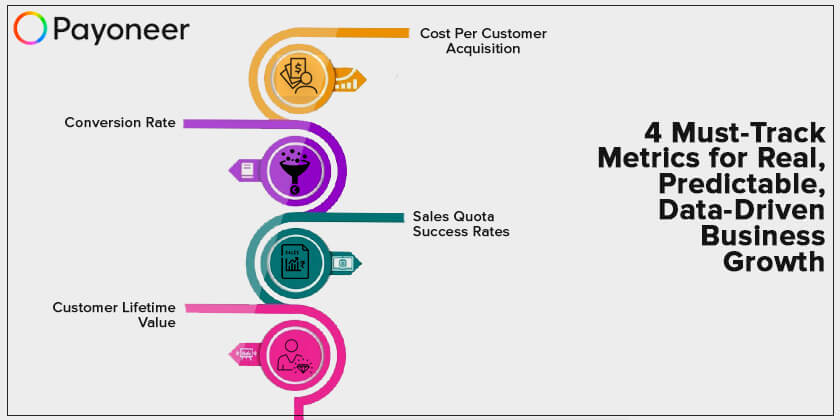
4 Must-Track Metrics for Real, Predictable, Data-Driven Business Growth
Editor’s Note: This is a guest post written by Nathan Resnick, CEO at Sourcify.
When it comes to growing your business, understanding which metrics matter most is essential. You could implement several different strategies as you attempt to grow your business, but without using data analytics to track your results, you’ll never know if your efforts are making a meaningful difference.
From conversion rates, to customer lifetime value, tracking metrics such as these detailed below are vital in order to see business growth.


The key to success is focusing on the metrics that help deliver real, predictable growth. In a nutshell, incorporating smart analytics processes into your business management routines involves keeping an eye on specific key performance indicator (KPI) metrics so you can take decisive action regarding the operation of your business.
Here we’ll cover the important business metrics to track, along with what makes them so significant as growth indicators.
1. Conversion Rate
Conversion rate is an essential starting point for any business’s data analytics efforts. This metric is often used on a broad scale, such as identifying how many website visitors end up buying a product. However, it can also be used on a more micro level, such as evaluating the rate for email list signups on a landing page.
For any business, of course, the most important conversion rate is the number that leads to a sale. Each industry has different conversion benchmarks and knowing the average conversion rate for your industry will help you see where you stand against the competition.
2. Cost Per Customer Acquisition
While increasing your website’s conversion rate is an important starting point, it doesn’t tell the whole story. You must evaluate the number of clients you’ve gained with your cost per customer acquisition in mind.
The cost per acquisition takes the total amount of your ad spend and divides it by the number of new customers gained from those efforts. For example, if you paid $1,000 for a Facebook ad campaign and gained 10 new customers, that means your cost per acquisition was $100. That’s great if each customer is buying a $500 product. Not so much if they’re only spending $5.
Naturally, the lower your customer acquisition costs, the more effective your strategy. Remember that this tends to be a starting point in discovering issues with your brand. A poor customer acquisition cost could mean you need to fine-tune your advertising campaign. But it also might mean your landing page needs to be overhauled. Continual analysis of this metric will help you continue making improvements to lower your costs.
3. Customer Lifetime Value
Depending on your business model, customers might make a single purchase and never come back to your site, or they might end up paying for your services on a monthly basis. The better you are able to retain customers, the greater their lifetime value will be.
One of the most commonly cited statistics in the business world is that increasing your retention rate by 5% can increase your profits by 25 to 95%. For predictable growth, your goal should be to increase your retention rates so you can improve your customer lifetime value. For internet brands, a Statista survey notes that fast and predictable shipping, the business’s perceived expertise and a personalized experience can all contribute to increased retention rates.
Of course, delivering superior service and products will also increase the lifetime value of your customers, as they are more likely to buy from you again after a positive initial experience. A growing lifetime value also makes advertising costs more effective.
4. Sales Quota Success Rates
Many B2B brands rely on sales teams to make direct pitches to their clients. As part of this process, teams are generally given sales quotas, or goals, that they are expected to reach on a monthly or quarterly basis. These goals are often used to make predictions for profit and growth.
Data analytics is crucial, not just for evaluating sales rep performance, but also in the effectiveness of the quota itself. As a general rule of thumb, at least 60% of the team should be able to meet their targets. If that’s not happening, it could be that your quota is not realistic, or for those who are falling short, dig into their challenges to help them. On the flip side, if 90% or more of your sales team is hitting quota, it’s an indicator that the targets are too low.
Adjusting sales quotas as needed could motivate your team to close even more sales, or help you set more realistic growth projections for your business. Fine-tuning your quotas will ensure that actual sales results don’t come as a shock.
Focus on the Right Metrics to Grow Your Brand
Whether you’re considering expanding into international markets or simply want to increase sales for a particular product line, tracking these metrics is essential for determining if your current strategy is yielding the results you want.
By using data analytics to better understand campaign results, you can find new ways to optimize your business practices and generate predictable growth and revenue.






